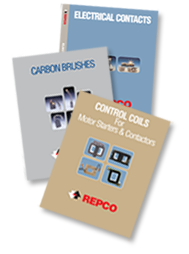COMMUTATOR SURFACE CONDITIONS |
|
| Satisfactory Conditions | |
|
Light Film - over the entire commutator surface is one of the many normal conditions often seen on a well-functioning machine. Film tone is dependent on the brush grade and current density. |
 |
|
Dark Film - if uniform over the entire commutator surface is acceptable. This condition can be the result of a high filming brush grade, higher current densities or the presence of chemical vapor contamination. |
 |
|
Blotchy Film - this non-uniform filming condition is the most common appearance. The accumulated tolerances in the machine such as commutator roundness, brush contact pressure, unequal magnetic fields and chemical vapors all contribute to this type of film development. |
 |
|
Slot Bar Filming - repeating light and dark filming patterns related to the number of armature coils per slot. This pattern is dependent on the machine design and usually not a function of the brush grade. |
 |
| Conditions of Concern | |
|
Streaking - the film, in and of itself, is not detrimental to the commutator. Brush and commutator life are not at risk in this condition. If metal transfer develops this condition will progress into threading. This type of filming can be dependent on current density or brush grade. |
 |
|
Bright Spots - a freckled appearance of the film usually caused by machines that are subjected to frequent overload cycles. If the bright spots disturb the film only, a machine can operate for long periods of time with this condition. If severe metal transfer begins, the bright spots could progress to dangerous bar burning or film stripping. |
 |
| Unsatisfactory Conditions | |
|
Bar Burning - is the erosion of the trailing edge of the commutator bar. Failed machine components, misadjusted electrical symmetry of the machine or a poor commutating brush can result in bar burning. If not corrected, this condition can cause severe commutator damage or a flashover. |
 |
|
Slot Bar Burning - results in commutator erosion of every second, third, or fourth bar depending on the winding design of the armature. Improper brush material, brush design or electrical adjustment of the machine can cause this condition. This condition severely damages the commutator and reduces brush life. |
 |
|
Threading - is machining of the commutator by copper particles imbedded in the brush face. The excessive copper transfer occurs due to low spring pressure, light loading or contamination. These particles are trapped in the porous carbon brush and harden, creating a tool that machines or gouges the commutator surface. The machine can operate for long periods of time with this condition, but reduced commutator and brush life will be the result. |
 |
|
Pitch Bar Burning - results in commutator bars being eroded in a pattern related to one-half the number of brush arms, progressing into a pattern equal to the number of brush arms. This condition is caused by a cyclic mechanical or electrical disturbance such as, an unbalanced armature, misaligned shafts, bent shaft, bad bearings, weak foundation, foiled equalizers or a poor riser connection. If not corrected this condition will result in a flashover. |
 |
|
Grooving - is the uniform circumferential wear of the brush width that is exhibited on the commutator. Excessive abrasive dusts in the atmosphere or on abrasive brush can cause this condition. Extreme light spring pressure (below 1 .5 psi) can also cause this condition. Proper brush applications and filtering the air on force-ventilated motors can reduce the commutator wear. Some people call this "Ridging" because of the resulting ridges on each side of the groove. |
 |
|
Copper Drag - occurs when high energy transfers copper in a molten state. These particles become coated by contaminants from the surrounding environment or the brush treatment and do not oxidize properly to form the film on the commutator surface. These particles accumulate at the edge of the bar, eventually shorting across the insulating mica. This condition needs to be addressed immediately when discovered or serious damage may occur. Chamfering the commutator bar edges is necessary to stop the progression of this condition. |
 |
|
|
|

- Electrical Contacts
Electrical Contacts
- Carbon Brushes
Carbon Brushes : Brush Reference
- Control Coils
Control Coils
- Other Contactor Parts
- More
- Search
- Auxiliary Contacts
Auxiliary Contacts
- Shunts
Shunts
- Springs
Springs
- AC Contactors & Starters
AC Contactors & Starters
- DC Contactors
DC Contactors
- Drives
Drives
- Fuses
Carbon Brushes (June 2012): Commutator Surface Conditions
June 26, 2012
« Return To Articles
Quick Contact
Newsletter Signup
Join our email list and we will keep you informed of sales and promotions and other great deals!
Email SubscribeRequest Literature
Request our Electrical Contact, Carbon Brush, or Control Coil catalogs (via Mail).
Request NowInternational: 856-762-0172
Domestic: 800-822-9190
Literature Request Or Download
Click here to download or browse our Electrical Contact, Carbon Brush, or Control Coil catalogs online.

Repco
100 Sonwil Drive
Buffalo NY 14225Repco Quick Contact
We are excited to announce that REPCO has merged with USA Industrials.
For all inquiries, please contact us at service@usaindustrials.com or give us a call at 800-822-9190.
We appreciate your understanding and look forward to serving you better with our expanded capabilities.
- Carbon Brushes